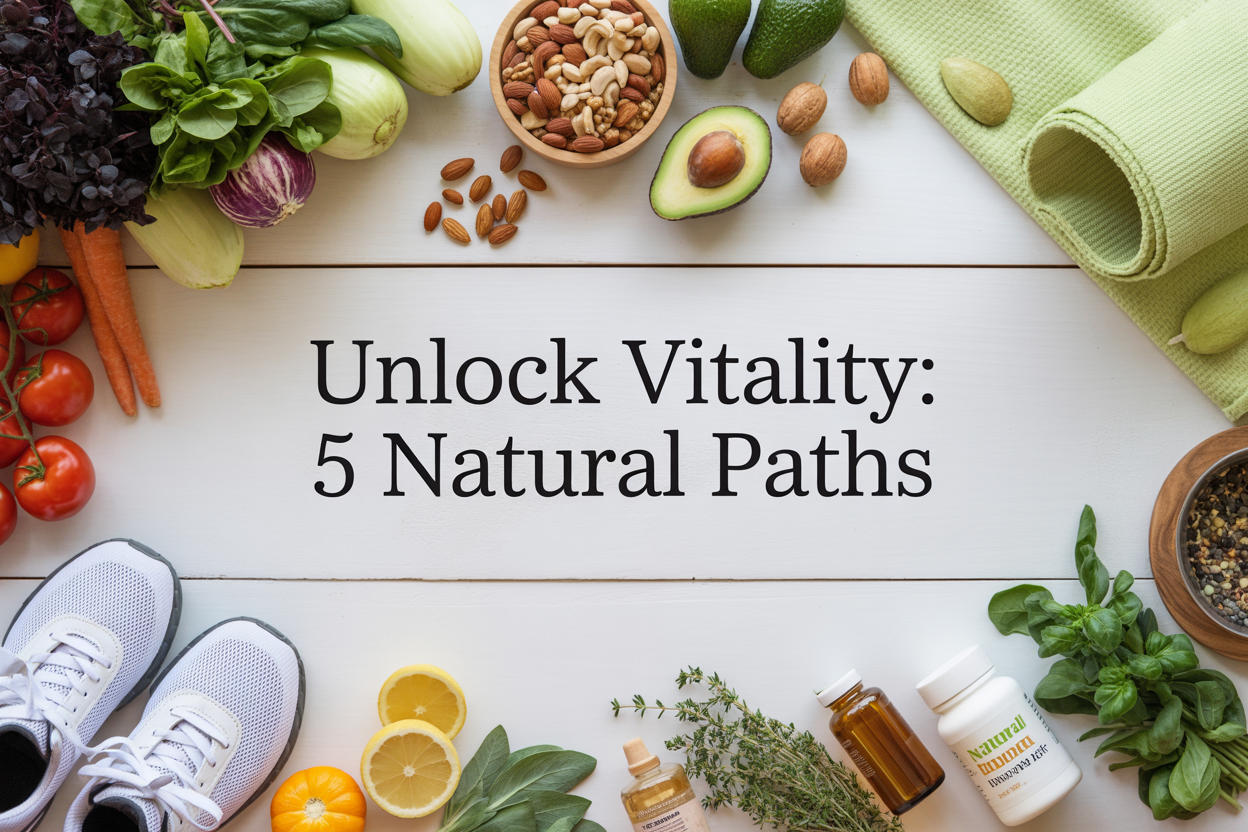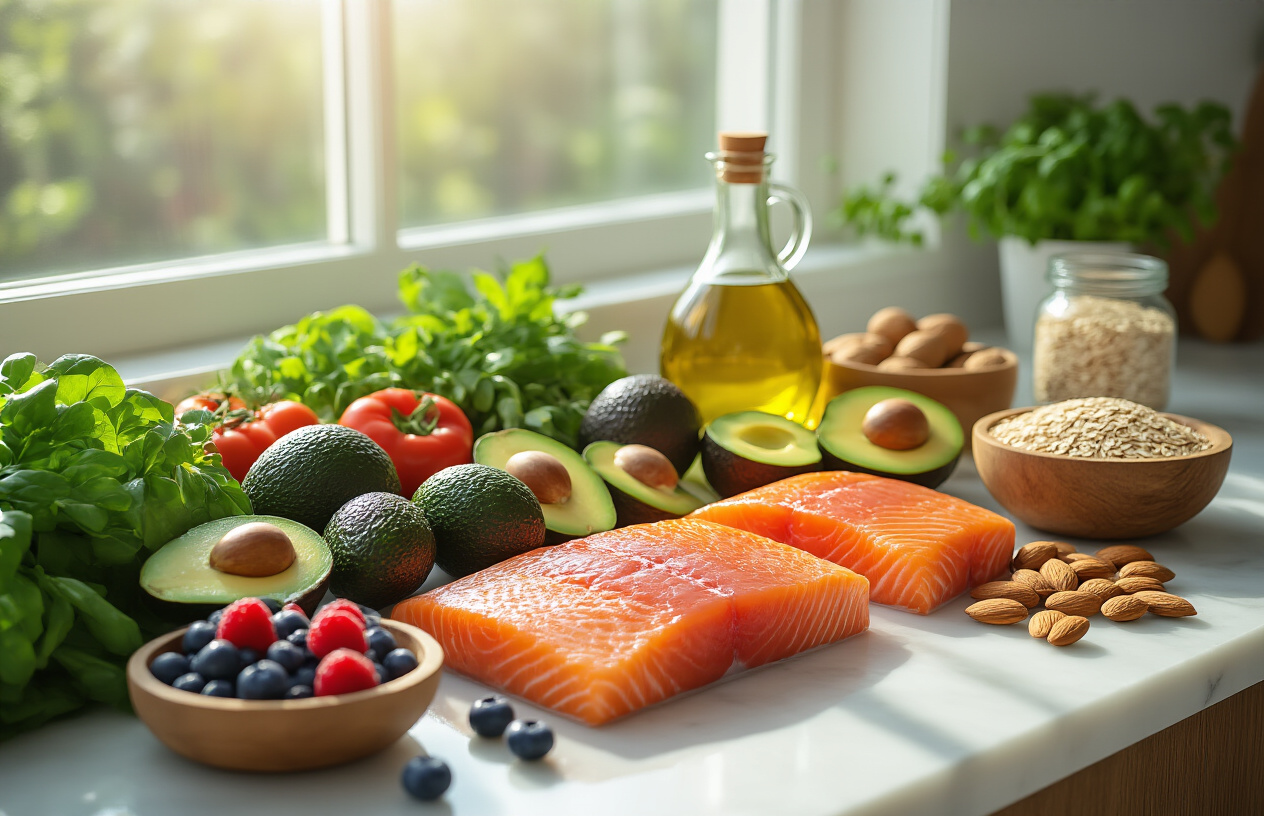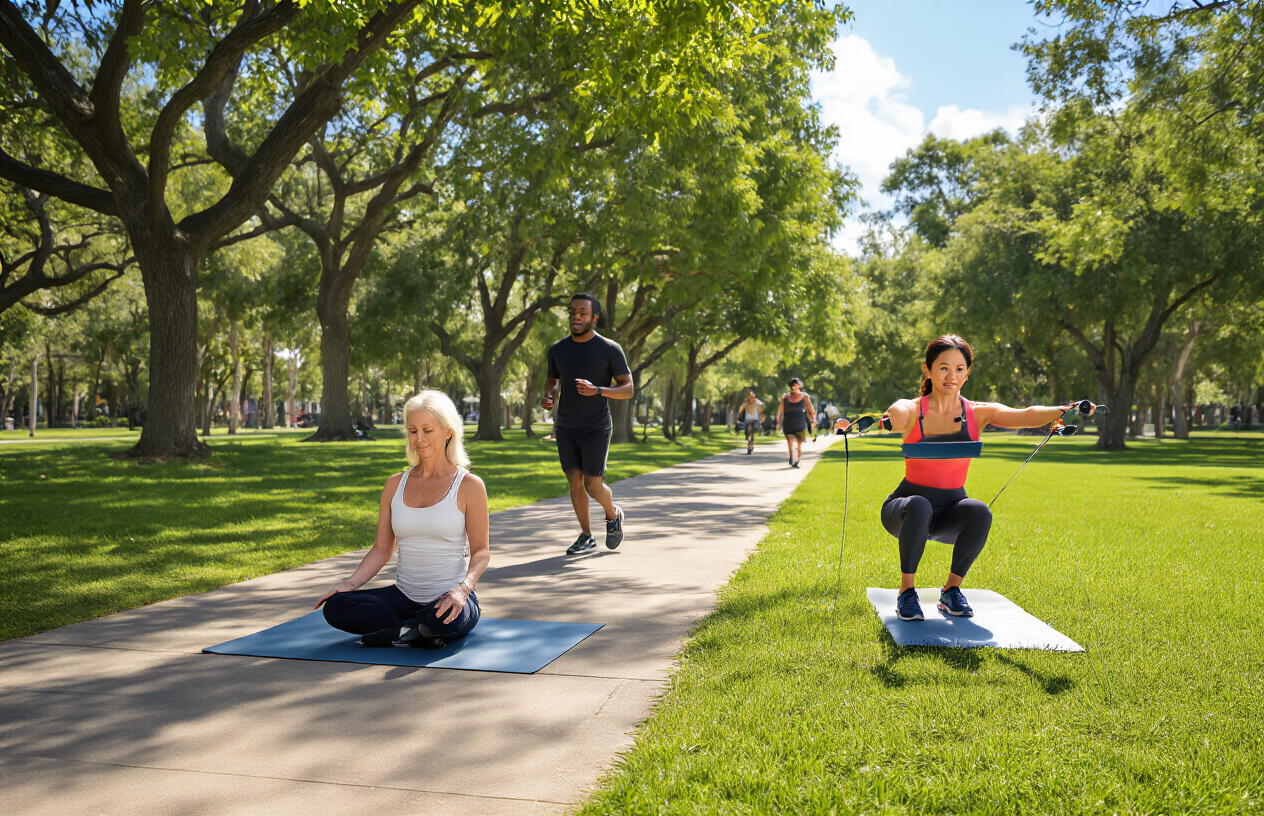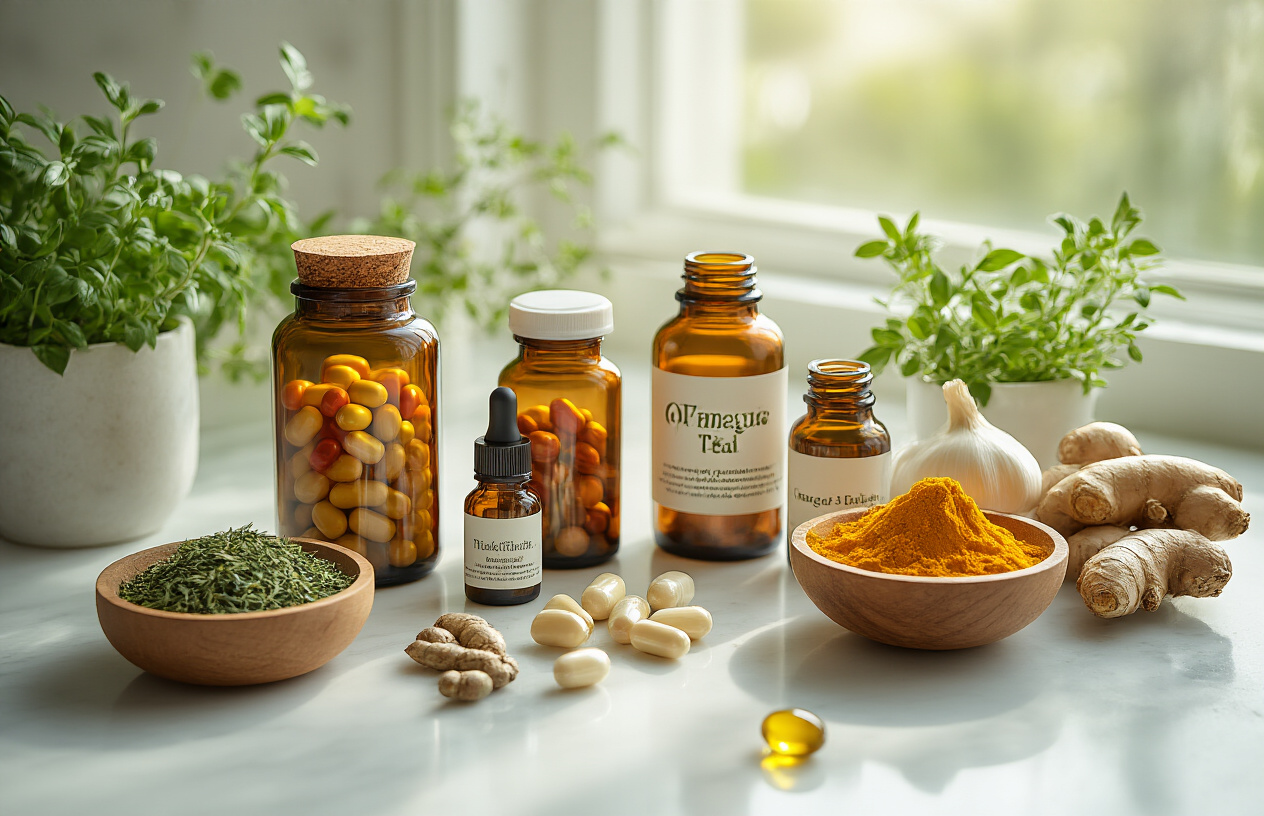Unlock Vitality: Discover 5 natural paths to lower cholesterol without medication. Boost heart health with diet, exercise, and lifestyle changes for lasting wellness.
Table of Contents
Unlock Vitality: 5 Natural Paths to Lower Cholesterol

High cholesterol affects millions of people worldwide, but prescription medications aren’t your only option. If you’re dealing with elevated cholesterol levels and want to explore natural alternatives, you can successfully lower cholesterol naturally through proven lifestyle strategies.
This guide is designed for health-conscious individuals who prefer natural ways to reduce cholesterol before turning to pharmaceutical solutions, or those looking to complement their existing treatment plan with holistic approaches.
You’ll discover how to harness the power of heart-healthy foods that actively fight bad cholesterol while boosting the good kind. We’ll also explore how strategic physical activity can transform your cholesterol profile faster than you might expect. Plus, you’ll learn practical stress reduction techniques that directly impact your heart health—because managing stress isn’t just about feeling better mentally.
Ready to take control of your cholesterol levels the natural way? Let’s dive into these five proven paths that can help you achieve healthier numbers without relying solely on medication.
Harness the Power of Heart-Healthy Foods

Incorporate Soluble Fiber Champions into Daily Meals
Soluble fiber acts like a sponge in your digestive system, binding with cholesterol particles and escorting them out of your body before they can wreak havoc on your arteries. Oats stand out as the superstar here—just one bowl of oatmeal provides 3-4 grams of beta-glucan, a potent cholesterol-fighting compound that can slash LDL levels by up to 10%.
Beans deserve equal recognition in your cholesterol-lowering diet. Black beans, kidney beans, and lentils pack 6-7 grams of soluble fiber per half-cup serving. Toss them into salads or soups, or create hearty stews that make lowering cholesterol feel effortless rather than restrictive.
Apples and pears bring natural sweetness while delivering pectin, another cholesterol-busting fiber. The magic happens when you eat the whole fruit—juicing strips away most of these beneficial compounds. Barley transforms ordinary soups into cholesterol-fighting powerhouses, while psyllium husk can be mixed into smoothies for an extra fiber boost.
| Soluble Fiber Food | Serving Size | Fiber Content | Best Preparation |
|---|---|---|---|
| Oats | 1 cup cooked | 4g | Steel-cut or rolled |
| Black beans | ½ cup | 6g | Soups, salads |
| Apples | 1 medium | 4g | Whole with skin |
| Barley | ½ cup cooked | 3g | Soups, stews |
Choose Omega-3 Rich Fish for Cardiovascular Protection
Fatty fish transforms your cardiovascular health through EPA and DHA—two omega-3 fatty acids that your body can’t produce on its own. These marine-derived compounds reduce inflammation in arterial walls and prevent dangerous blood clots from forming.
Salmon leads the pack with 1,800 mg of omega-3s per 3.5-ounce serving. Wild-caught varieties contain higher concentrations than farmed fish, though both options support heart-healthy foo goals. Mackerel delivers even more punch with 2,600 mg per serving, making it one of the most efficient ways to boost your omega-3 intake.
Sardines might seem humble, but they’re nutritional powerhouses containing 1,400 mg of omega-3s plus calcium and vitamin D. Their smaller size means less mercury accumulation, making them safer for frequent consumption. Anchovies work wonderfully in pasta dishes and salad dressings, providing 1,200 mg of these essential fats.
The American Heart Association recommends eating fatty fish twice weekly. Grilling, baking, or poaching preserves the delicate omega-3 structure better than frying. Canned fish counts too—lookor varieties packed in water rather than oil to avoid unnecessary calories.
Add Nuts and Seeds for Natural Cholesterol Management
Raw almonds contain monounsaturated fats that actively lower LDL cholesterol while maintaining beneficial HDL levels. Studies show eating 1.5 ounces a day can reduce cholesterol by 5–10%. Their vitamin E content protects against oxidation, preventing cholesterol from becoming the sticky, artery-clogging type.
Walnuts bring alpha-linolenic acid (ALA), a plant-based omega-3 that supports cardiovascular function. Just a handful provides 2.5 grams of ALA along with fiber and plant sterols. Their unique combination of nutrients makes them particularly effective for natural ways to reduce cholesterol.
Flaxseeds deserve recognition for their triple threat: omega-3s, lignans, and soluble fiber. Ground flaxseeds work better than whole ones since your digestive system can’t crack their tough outer shell. Sprinkle them on yogurt, blend them them into smoothies, or add them them to baking recipes.
Chia seeds expand in liquid, creating a gel-like consistency that slows cholesterol absorption. They’re virtually flavorless, making them easy to incorporate into puddings, oatmeal, or homemade energy bars.
Best practices for nuts and seeds:
- Buy raw, unsalted varieties
- Store in airtight containers or refrigerator
- Portion control: 1-2 ounces daily
- Rotate different types for varied nutrients
Embrace Plant Sterols Through Whole Foods
Plant sterols mimic cholesterol’s structure so effectively that they trick your digestive system into absorbing them instead of dietary cholesterol. This natural deception can reduce cholesterol absorption by up to 50% when you consume 2–3 grams of whole foods daily.
Vegetable oils naturally contain plant sterols, with corn oil and sesame oil leading the concentration charts. However, you’ll get more bang for your buck from whole food sources that provide additional nutrients alongside these cholesterol-blocking compounds.
Brussels sprouts, broccoli, and cauliflower belong to the cruciferous family that’s rich in plant sterols. Steam them lightly to preserve heat-sensitive compounds, or roast with olive oil for enhanced absorption of fat-soluble vitamins.
Avocados combine plant sterols with heart-healthy monounsaturated fats. Half an avocado provides about 100 mg of plant sterols plus fiber and potassium. Their creamy texture makes them perfect for spreading on whole grain toast or blending into smoothies.
Whole grains like brown rice, quinoa, and whole wheat contain modest amounts of plant sterols. While individual servings might seem small, these foods typically form the foundation of meals, allowing sterols to accumulate throughout the day. Choose minimally processed grains whenever possible since refining removes much of the sterol content.
Transform Your Lifestyle with Strategic Physical Activity

Design Low-Impact Cardio Routines for Maximum Benefits
Your heart doesn’t need high-intensity pounding to get stronger and help you lower cholesterol naturally. Walking remains one of the most effective cardiovascular exercises for improving heart health and managing cholesterol levels. Start with 15-20 minutes of brisk walking daily and gradually build up to 30-45 minutes. The beauty of walking lies in its accessibility—youan do it anywhere, anytime, without special equipment.
Swimming offers another excellent low-impact option that engages your entire body while being gentle on joints. The water’s buoyancy supports your body weight, making it perfect for people with arthritis or joint concerns. Aim for 20-30 minutes of continuous swimming or water aerobics three times per week.
Cycling, whether stationary or outdoor, provides cardiovascular benefits while being easier on your knees than running. Start with 20 minutes and work your way up to 45 minutes per session. You can spice up your routine and get more motivated by taking indoor cycling classes.
Elliptical machines combine upper and lower body movement without the jarring impact of running. These machines allow you to control intensity while maintaining steady, rhythmic movement that your cardiovascular system loves.
The key to successful cardio for cholesterol management is consistency rather than intensity. Your target should be moderate intensity,, where you can still hold a conversation but feel your heart rate elevated. This sweet spot maximizes fat burning and cholesterol reduction while minimizing injury risk.
Build Strength Training into Your Weekly Schedule
Muscle-building exercises play a crucial role in your natural cholesterol management strategy. Strength training boosts your metabolism, helping your body process fats more efficiently and supporting healthy cholesterol levels. You don’t need a gym membership or expensive equipment to get started.
Bodyweight exercises form the foundation of effective strength training. Push-ups, squats, lunges, and planks target multiple muscle groups simultaneously. Start with 2-3 sets of 8-12 repetitions for each exercise. If regular push-ups feel too challenging, begin with wall push-ups or knee push-ups and progress gradually.
Resistance bands offer versatile, portable strength training options. These inexpensive tools provide variable resistance that challenges your muscles throughout the entire range of motion. You can perform rows, chest presses, and leg extensions anywhere with proper anchoring.
Free weights, including dumbbells and kettlebells, allow for progressive overload—graduallyncreasing weight as you get stronger. Start with lighter weights,, focusing on proper form rather than heavy lifting. Basic movements like bicep curls, shoulder presses, and deadlifts work multiple muscle groups effectively.
Schedule strength training sessions 2-3 times per week, allowing at least one day of rest between sessions for muscle recovery. Each session should last 30–45 minutes and target different muscle groups. Monday might focus on the upperpper body, Wednesday on the lowerower body, and Friday on full-body movements.
Compound movements like squats, deadlifts, and rows burn more calories and provide better overall benefits than isolated exercises. These movements engage multiple muscle groups, making your workouts more efficient and effective for cholesterol management.
Discover Fun Activities That Keep You Moving Consistently
Making physical activity enjoyable transforms exercise from a chore into something you actually look forward to. Dancing ranks among the most entertaining ways to get your heart pumping while improving coordination and mood. Whether you prefer salsa, swing, or simply dancing to your favorite music at home, you’re getting cardiovascular benefits without feeling like you’re exercising.
Gardening provides moderate physical activity while connecting you with nature. Digging, planting, weeding, and watering all contribute to your daily movement goals. An hour of gardening burns approximately 250-350 calories while producing fresh vegetables and herbs for your heart-healthy diet.
Playing with pets, especially dogs, naturally increases your activity level. Dog walking, playing fetch, or running around the backyard with your furry friend adds joy to exercise while strengthening your bond. Pet owners typically get more daily steps than non-pet owners.
Group activities and sports add social elements that make movement more engaging. Join a recreational volleyball league, try pickleball, or participate in community walking groups. The social accountability and friendship aspects help maintain long-term consistency.
Household activities count toward your movement goals too. Vacuuming, mopping, washing cars, and organizing closets all burn calories and contribute to your overall activity level. Put on energetic music and turn chores into mini-workout sessions.
Seasonal activities keep exercise fresh and exciting throughout the year. Summer brings swimming, hiking, and outdoor festivals. Fall offers apple picking and leaf raking. Winter provides opportunities for snowshoeing or indoor rock climbing. Spring calls for bike rides and outdoor sports.
The secret to sustainable activity lies in variety and enjoyment. Rotate different activities weekly to prevent boredom and work different muscle groups. Track your progress with a simple journal or smartphone app, celebrating small victories along the way.
Master Stress Reduction Techniques for Better Heart Health

Practice Mindfulness Meditation for Daily Calm
Chronic stress triggers your body to produce more cortisol, which directly impacts cholesterol production in your liver. When you’re constantly stressed, your body ramps up cholesterol synthesis as part of the fight-or-flight response, making stress reduction and and heart health critical componentsof your cholesterol management strategy.
Mindfulness meditation offers a powerful antidote to this stress cycle. Start with just 5-10 minutes each morning, focusing on your breath and observing thoughts without judgment. Apps like Headspace or Calm can guide you through beginner-friendly sessions. Research shows that people who meditate regularly experience up to a a 23% reduction in stress hormones, which translates to better cholesterol profiles over time.
The beauty of mindfulness lies in its simplicity. You don’t need special equipment or a perfect environment. Find a quiet corner, sit comfortably, and focus on the present moment. Even brief mindfulness breaks during stressful workdays can help reset your nervous system and prevent cortisol spikes.
Implement Deep Breathing Exercises Throughout Your Day
Your breath serves as a direct line to your nervous system, offering instant stress relief that supports your natural ways to reduce cholesterol goals. When stress hits, shallow breathing becomes the norm, keeping your body in a state of chronic tension that elevates cholesterol production.
The 4-7-8 breathing technique works wonders for immediate calm. Inhale through your nose for 4 counts, hold for 7 counts, then exhale slowly through your mouth for 8 counts. This pattern activates your parasympathetic nervous system, signaling your body to shift from stress mode to rest mode.
Box breathing offers another effective option: breathe in for 4 counts, hold for 4, exhale for 4, and pause for 4 before repeating. Navy SEALs use this technique to maintain composure under extreme pressure, and you can apply it during traffic jams, difficult conversations, or whenever tension builds.
Practice these techniques at red lights, before meals, or during work breaks. The more you integrate deep breathing into your daily routine, the more your body learns to maintain lower stress levels naturally.
Create Relaxing Evening Routines to Improve Sleep Quality
Poor sleep quality creates a domino effect that sabotages your cholesterol levels. When you’re sleep-deprived, your body produces more ghrelin (hunger hormone) and less leptin (satiety hormone), leading to cravings for high-cholesterol foods. Sleep deprivation also increases cortisol production, directly impacting cholesterol synthesis.
Design an evening routine that signals to your body it’s time to wind down. Start dimming lights two hours before bedtime to encourage natural melatonin production. Replace screen time with relaxing activities like reading, gentle stretching, or listening to calming music.
A warm bath with Epsom salts can work wonders for both stress relief and sleep preparation. The magnesium in Epsom salts helps relax muscles and calm the nervous system. Add a few drops of lavender essential oil for extra relaxation benefits.
Keep your bedroom cool (around 65-68°F), dark, and quiet. Consider blackout curtains or a sleep mask, and use earplugs or a white noise machine if needed. Your bedroom should be a sanctuary dedicated solely to rest and relaxation.
Engage in Nature-Based Activities for Mental Reset
Nature provides a powerful stress-reduction tool that supports your healthy lifestyle for cholesterol management. Studies reveal that spending just 20 minutes in natural settings significantly reduces cortisol levels, which helps maintain healthier cholesterol production patterns.
Forest bathing, or simply spending mindful time among trees, offers profound stress-relief benefits. The practice originated in Japan, where researchers discovered that breathing in forest air (rich in beneficial compounds called phytoncides) reduces stress hormones by up to 50%.
If forests aren’t accessible, any green space works. City parks, gardens, or even a single tree in your neighborhood can provide stress relief. The key lies in mindful engagement with nature rather than treating outdoor time as another item on your to-do list.
Gardening combines the benefits of nature exposure with gentle physical activity. Working with soil has been shown to increase serotonin levels naturally, while the rhythmic motions of planting, weeding, and watering create a meditative experience that calms the mind.
Water-based activities like walking beside lakes, rivers, or oceans amplify nature’s stress-reducing effects. The sound of moving water naturally lowers blood pressure and promotes relaxation, creating an ideal environment for stress recovery and cholesterol regulation.
Optimize Your Weight Through Natural Methods

Establish Sustainable Portion Control Strategies
Weight management plays a crucial role in your journey to lower cholesterol naturally. When you maintain a healthy weight, your body produces less LDL (bad) cholesterol while boosting HDL (good) cholesterol levels.
The secret to lasting portion control isn’t about depriving yourself—it’sbout smart strategies that become second nature. Start by using smaller plates and bowls, which tricks your brain into feeling satisfied with less food. A 9-inch plate instead of a 12-inch one can reduce your intake by up to 22% without feeling restricted.
Practice the plate method: fill half your plate with vegetables, one quarter with lean protein, and one quarter with whole grains. This cholesterol-lowering diet approach naturally controls portions while providing essential nutrients.
Eat slowly and put your fork down between bites. Your brain needs about 20 minutes to register fullness, so rushing through meals often leads to overeating. Chew each bite thoroughly and engage in conversation during meals to naturally pace yourself.
Pre-portion snacks into individual containers or bags. When you’re hungry, you’ll grab the pre-measured amount instead of eating straight from the package. Keep healthy options like nuts, berries, or cut vegetables readily available.
Listen to your body’s hunger cues. Eat when you’re genuinely hungry (stomach growling, low energy) and stop when you’re satisfied, not stuffed. Rate your hunger on a scale of 1-10, and aim to eat when you’re at a 3-4 and stop at a 7.
Time Your Meals for Enhanced Metabolism
Meal timing significantly impacts your metabolism and cholesterol levels. Your body’s internal clock affects how efficiently you process food and burn calories throughout the day.
Eat your largest meal earlier in the day when your metabolism runs highest. Research shows that people who consume a substantial breakfast and moderate lunch, followed by a lighter dinner, experience better weight loss and improved cholesterol profiles. Your body burns calories most efficiently in the morning and afternoon.
Space your meals 3–4 hours apart to keep your metabolism active and your blood sugar stable. This prevents the feast-or-famine cycle that can trigger cholesterol production and fat storage. Regular meal timing helps your liver regulate cholesterol synthesis more effectively.
Stop eating 2-3 hours before bedtime. Late-night eating disrupts your body’s natural repair processes and can increase triglyceride levels. Your digestive system needs time to process food before you sleep, and eating late interferes with the hormones that regulate hunger and metabolism.
Consider intermittent fasting patterns that work with your lifestyle. A 12-hour eating window (like 7 AM to 7 PM) gives your digestive system adequate rest while supporting healthy cholesterol levels. Start gradually by extending the time between your last meal and breakfast the next day.
Plan your meals and snacks ahead of time. This prevents impulsive food choices and ensures you’re eating at optimal times for your metabolism.
Stay Hydrated with Cholesterol-Fighting Beverages
Proper hydration supports your body’s natural ability to manage cholesterol levels. The right beverages can actively help reduce cholesterol without medication while keeping you well-hydrated.
Green tea tops the list of natural cholesterol remedies. Its catechins and antioxidants help lower LDL cholesterol while protecting your arteries from damage. Aim for 2-3 cups daily, preferably between meals to maximize absorption. The polyphenols in green tea also boost fat burning and support healthy weight maintenance.
Water remains your most important beverage choice. Drinking adequate water (half your body weight in ounces daily) helps your liver process cholesterol more efficiently and supports overall cardiovascular health. Start your day with a large glass of water to kickstart your metabolism.
Oat milk and soy milk contain beta-glucan and plant sterols that actively reduce cholesterol absorption in your intestines. Choose unsweetened varieties to avoid added sugars that can raise triglycerides.
Vegetable juices, particularly those made from beets, carrots, and leafy greens, provide nitrates that support healthy blood pressure and circulation. Make fresh juices at home to control sodium content and avoid preservatives.
| Beverage | Cholesterol Benefit | Daily Amount |
|---|---|---|
| Green Tea | Lowers LDL cholesterol | 2-3 cups |
| Water | Supports liver function | Half body weight (oz) |
| Oat Milk | Blocks cholesterol absorption | 1-2 servings |
| Vegetable Juice | Provides heart-healthy nutrients | 8 oz |
Limit alcohol consumption, as excessive intake raises triglycerides and interferes with your liver’s ability to manage cholesterol. If you drink, stick to moderate amounts: one drink daily for women, two for men.
Avoid sugary drinks, energy drinks, and excessive caffeine, which can spike insulin levels and promote cholesterol production. Replace sodas with sparkling water infused with fresh fruits or herbs for flavor without the negative health impacts.
Leverage Natural Supplements and Herbal Remedies

Explore Plant-Based Supplements with Proven Results
When exploring natural supplementcholesterol options, several plant-based remedies stand out for their scientifically backed cholesterol-lowering properties. Red yeast rice contains naturally occurring statins and has shown remarkable results in reducing LDL cholesterol by 15–25% in clinical studies. Berberine, extracted from various plants including goldenseal and barberry, works by activating an enzyme that helps regulate cholesterol production in the liver.
Psyllium husk offers a dual benefit—it’soth a fiber supplement and cholesterol reducer, binding to cholesterol in the digestive system and preventing absorption. Studies show that consuming 10–12 grams daily can lower LDL cholesterol by up to 7%. Plant sterols and stanols, naturally found in nuts and seeds but available in concentrated supplement form, block cholesterol absorption and can reduce levels by 6-15%.
Garlic extract provides allicin compounds that support healthy cholesterol metabolism, while artichoke leaf extract contains cynarin, which stimulates bile production and helps process cholesterol more efficiently. Green tea extract offers catechins that prevent cholesterol oxidation and support overall heart health.
| Supplement | Daily Dose | Expected LDL Reduction |
|---|---|---|
| Red Yeast Rice | 1200-2400mg | 15-25% |
| Berberine | 900-1500mg | 20-25% |
| Psyllium Husk | 10-12g | 5-7% |
| Plant Sterols | 2-3g | 6-15% |
Understand Proper Dosing for Maximum Effectiveness
Getting the dosage right makes the difference between seeing results and wasting money on herbal remedies and and cholesterol treatments. Start with the lowest effective dose and gradually increase as your body adapts. Red yeast rice should begin at 600 mgg twice daily with meals, potentially increasing to 1200 mgg twice daily based on your response and cholesterol levels.
Berberine works best when split into three doses of 300-500 mgg each, taken before meals to maximize absorption and minimize digestive upset. The compound has a short half-life, so spacing doses throughout the day maintains steady blood levels.
Psyllium husk requires careful attention to fluid intake—alwaysonsume with at least 8 ounces of water per 5-gram serving to prevent digestive blockage. Start with 5 grams daily and increase by 2.5 grams weekly until you reach the target dose of 10-12 grams.
Plant sterols and stanols work best when consumed with meals containing dietary fats, as they need fat for proper absorption. Timing matters too—takeholesterol-supporting supplements 30 minutes before meals when possible, as this allows them to be present in your digestive system when dietary cholesterol arrives.
Learn Safe Combinations with Existing Medications
Combining natural cholesterol remedies with prescription medications requires careful coordination with your healthcare provider. Some natural supplements can enhance the effects of cholesterol medications, potentially leading to dangerously low cholesterol levels or increased side effects.
Red yeast rice contains natural statins, so combining it with prescription statins like atorvastatin or simvastatin can cause muscle damage or liver problems. If you’re taking blood thinners, garlic supplements may increase bleeding risk due to their anticoagulant properties.
Berberine can lower blood sugar levels, making it potentially problematic for people taking diabetes medications without proper monitoring. It also affects how the liver processes certain drugs, potentially increasing or decreasing their effectiveness.
Safe combination strategies:
- Space natural supplements at least 2 hours apart from prescription medications
- Monitor cholesterol levels every 6-8 weeks when starting new combinations
- Watch for unusual fatigue, muscle pain, or digestive issues
- Keep a supplement diary noting timing and any side effects
- Never stop prescription medications without medical supervision
Psyllium husks can interfere with medication absorption when taken simultaneously, but this risk disappears when you space them 2–4 hours apart.
Identify Quality Sources for Natural Health Products
The supplement industry lacks the strict regulation of pharmaceuticals, making quality sourcing critical for natural ways to reduce cholesterol. Third-party testing provides the gold standard for supplement verification—look for products certified by NSF International, USP (United States Pharmacopeia), or ConsumerLab.com.
Reputable manufacturers voluntarily submit their products for testing of purity, potency, and contaminants. These certifications appear as seals on product labels and indicate the supplement contains what the label claims without harmful additives like heavy metals, pesticides, or undeclared ingredients.
Quality indicators to look for:
- GMP (Good Manufacturing Practices) certification
- Standardized extracts with specified active compound percentages
- Expiration dates and lot numbers for traceability
- Clear labeling of all ingredients and their sources
- Company contact information and customer service availability
Avoid products with proprietary blends that don’t specify individual ingredient amounts, as these make it impossible to determine effective dosing. Purchase from established retailers with favorable return policies and customer reviews that specifically mention third-party testing results.
Consider working with a naturopathic doctor or functional medicine practitioner who can recommend pharmaceutical-grade supplements from professional lines, which typically undergo more rigorous testing than consumer-grade products.
Track Progress and Adjust Your Natural Approach
Monitoring your body’s response to natural supplements and cholesterol treatments helps optimize your regimen and ensures safety. Establish baseline measurements before starting any new supplement program, including total cholesterol, LDL, HDL, and triglycerides through lipid panel testing.
Track both objective measurements and subjective feelings. Keep a daily log noting energy levels, sleep quality, digestive changes, and any side effects. Many people notice improved energy and better digestion within 2-3 weeks of starting natural cholesterol support, while measurable cholesterol changes typically appear after 6-8 weeks of consistent use.
Effective tracking methods:
- Monthly photos and weight measurements
- Weekly blood pressure readings if you have hypertension
- Quarterly lipid panel tests to measure cholesterol changes
- Daily symptom and energy level ratings (1-10 scale)
- Food and supplement timing logs to identify optimal schedules
Adjust your approach based on results and tolerability. If you experience digestive upset with berberine, try taking it with food or reducing the dose. Poor results after 12 weeks may indicate the need for different supplements or higher doses.
Create realistic expectations—natural approaches typically reduce cholesterol by 10-30%, which may not be sufficient for everyone. Some people respond better to certain supplements than others based on genetics, diet, and lifestyle factors. Regular communication with your healthcare provider ensures your natural approach complements rather than conflicts with your overall health strategy.

Taking control of your cholesterol doesn’t have to mean relying solely on medications or drastic lifestyle changes. The five natural approaches we’ve explored—eating heart-healthy foods, staying active, managing stress, maintaining a healthy weight, and incorporating natural supplements—work together to create a powerful foundation for better cardiovascular health. Each path offers its own benefits, but when combined, they create a comprehensive approach that can significantly impact your cholesterol levels and overall vitality.
Start with small, manageable changes rather than trying to overhaul everything at once. Pick one area that resonates most with you, whether it’s adding more fiber-rich foods to your meals or taking a 20-minute walk each day. Once you’ve mastered these habits, gradually integrate the other strategies. Your heart will thank you for every positive step you take, and you’ll likely find that these natural methods not only help lower your cholesterol but also boost your energy and improve your quality of life.
Share this content: